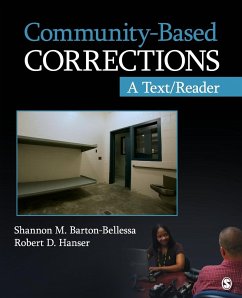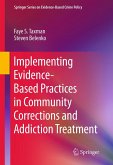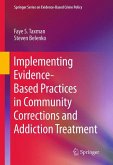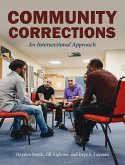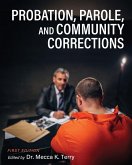- Broschiertes Buch
- Merkliste
- Auf die Merkliste
- Bewerten Bewerten
- Teilen
- Produkt teilen
- Produkterinnerung
- Produkterinnerung
Presenting a more practical viewpoint than other texts available for the course, this book offers a unique textbook/reader alternative to the traditional textbook format. The book is divided into 11 author-written sections that present basic concepts, key terms, and recent data. Each section is followed by two to three cutting-edge, research-based articles.
Andere Kunden interessierten sich auch für
![Implementing Evidence-Based Practices in Community Corrections and Addiction Treatment Implementing Evidence-Based Practices in Community Corrections and Addiction Treatment]() Faye S. TaxmanImplementing Evidence-Based Practices in Community Corrections and Addiction Treatment90,99 €
Faye S. TaxmanImplementing Evidence-Based Practices in Community Corrections and Addiction Treatment90,99 €![Implementing Evidence-Based Practices in Community Corrections and Addiction Treatment Implementing Evidence-Based Practices in Community Corrections and Addiction Treatment]() Faye S. TaxmanImplementing Evidence-Based Practices in Community Corrections and Addiction Treatment75,99 €
Faye S. TaxmanImplementing Evidence-Based Practices in Community Corrections and Addiction Treatment75,99 €![Essentials of Community Corrections Essentials of Community Corrections]() Robert D. HanserEssentials of Community Corrections136,99 €
Robert D. HanserEssentials of Community Corrections136,99 €![Community Corrections Community Corrections]() Hayden SmithCommunity Corrections183,99 €
Hayden SmithCommunity Corrections183,99 €![Community Corrections Community Corrections]() Hayden SmithCommunity Corrections133,99 €
Hayden SmithCommunity Corrections133,99 €![Probation, Parole, and Community Corrections Probation, Parole, and Community Corrections]() Probation, Parole, and Community Corrections78,99 €
Probation, Parole, and Community Corrections78,99 €![Intersections of the Legal System and the Deaf Community Intersections of the Legal System and the Deaf Community]() David M. FeldmanIntersections of the Legal System and the Deaf Community38,99 €
David M. FeldmanIntersections of the Legal System and the Deaf Community38,99 €-
-
-
Presenting a more practical viewpoint than other texts available for the course, this book offers a unique textbook/reader alternative to the traditional textbook format. The book is divided into 11 author-written sections that present basic concepts, key terms, and recent data. Each section is followed by two to three cutting-edge, research-based articles.
Hinweis: Dieser Artikel kann nur an eine deutsche Lieferadresse ausgeliefert werden.
Hinweis: Dieser Artikel kann nur an eine deutsche Lieferadresse ausgeliefert werden.
Produktdetails
- Produktdetails
- Verlag: Sage Publications, Inc
- Seitenzahl: 658
- Erscheinungstermin: 6. Januar 2011
- Englisch
- Abmessung: 235mm x 191mm x 35mm
- Gewicht: 1208g
- ISBN-13: 9781412987462
- ISBN-10: 1412987466
- Artikelnr.: 31249739
- Herstellerkennzeichnung
- Libri GmbH
- Europaallee 1
- 36244 Bad Hersfeld
- gpsr@libri.de
- Verlag: Sage Publications, Inc
- Seitenzahl: 658
- Erscheinungstermin: 6. Januar 2011
- Englisch
- Abmessung: 235mm x 191mm x 35mm
- Gewicht: 1208g
- ISBN-13: 9781412987462
- ISBN-10: 1412987466
- Artikelnr.: 31249739
- Herstellerkennzeichnung
- Libri GmbH
- Europaallee 1
- 36244 Bad Hersfeld
- gpsr@libri.de
Shannon M. Barton-Bellessa is a professor of criminology and criminal justice at Indiana State University. She earned her undergraduate degree from Kentucky Wesleyan College, her master¿s degree from Eastern Kentucky University, and her PhD from the University of Cincinnati. Her journal publications have been in the area of community corrections, correctional officer job satisfaction, cognitive programming, and the juvenile justice system.
Foreword
Preface
Acknowledgments
Section I. History and Development of Community-Based Corrections
How to Read a Research Article
Readings:
1. The Ethics of Community-Based Sanctions, by Andrew von Hirsch
2. What Influences Offenders¿ Willingness to Serve Alternative Sanctions?
by David C. May and Peter B. Wood
3. When the Policy Becomes the Problem: Criminal Justice in the New
Millennium, by Sara Steen and Rachel Bandy
Section II. Pretrial Release and Diversion
Readings:
4. The Impact of Gender and Race-Ethnicity in the Pretrial Release Process,
by Stephen Demuth and Darrell Steffensmeier
5. State Administration of Drug Courts: Exploring Issues of Authority,
Funding, and Legitimacy, by Cary Heck and Aaron Roussell
Section III. Restorative Justice
Readings:
6. Restorative Practices in Instituttional Settings and at Release: Victim
Wrap Around Programs, by Martha Henderson Hurley
7. The Effectiveness of Restorative Justice Practices: A Meta-Analysis, by
Jeff Latimer, Craig Dowden, and Danielle Muise
Section IV. The Viability of Treatment Perspectives
Readings:
8. A Quasi-Experimental Evaluation of Thinking for a Change: A "Real-World"
Application, by Christopher T. Lowenkamp, Dana Hubbard, Matthew D.
Makarios, and Edward J. Latessa
9. Offender Coercion in Treatment: A Meta-Analysis of Effectiveness, by
Karen K. Parhar, J. Stephen Wormith, Dena M. Derkzen, and Adele M.
Beauregard
Section V. Assessment and Risk Prediction
Readings:
10. The LSI-R and the COMPAS: Validation Data on Two Risk-Needs Tools, by
Tracy L. Fass, Kirk Heilbrun, David DeMatteo, and Ralph Fretz
11. Can 14,737 Women Be Wrong? A Meta-Analysis of the LSI-R and Recidivism
for Female Offenders, by Paula Smith, Francis T. Cullen, and Edward J.
Latessa
Section VI. Probation Management and Case Planning
Readings:
12. Attorney Views on the Use of Private Agencies for Probation Supervision
and Treatment, by Leanne Fiftal Alarid and Christine S. Schloss
13. From the Inside: The Meaning of Probation to Probationers, by Brandon
K. Applegate, Hayden P. Smith, Alicia H. Sitren, and Nicolette Fariello
Springer
14. Gender Matters: Differences in State Probation Officer Stress, by Terry
Wells, Sharla Colbert, and Risdon N. Slate
Section VII. Community-Based Residential Intermediate Sanctions
Readings:
15. Removing a Nail From the Boot Camp Coffin: An Outcome Evaluation of
Minnesotäs Challenge Incarceration Program, by Grant Duwe and Deborah
Kerschner
16. Post-Release Substance Abuse Treatment for Criminal Offenders: A
Cost-Effectiveness Analysis, by Kathryn E. McCollister, Michael T. French,
James A. Inciardi, Clifford A. Butzin, Steven S. Martin, and Robert M.
Hooper
Section VIII. Community-Based Nonresidential and Economic Intermediate
Sanctions
Readings:
17. The Effectiveness of Community Service Sentences Compared to
Traditional Fines for Low-Level Offenders, by Jeffrey A. Bouffard and Lisa
R. Mufti
18. Day Reporting Center Completion: Comparison of Individual and
Multilevel Models, by Amy Craddock
19. Under Surveillance: An Empirical Test of the Effectiveness and
Consequences of Electronic Monitoring, by Kathy G. Padgett, William D.
Bales, and Thomas G. Blomberg
Section IX. Parole Management, Case Planning, and Reentry
Readings:
20. Does Parole Work? - Revisited: Reframing the Discussion of the Impact
of Postprison Supervision on Offender Outcome, by Melinda D. Schlager and
Kelly Robbins
21. "Punishment on the Installment Plan": Individual-Level Predictors of
Parole Revocations in Four States, by Sara Steen and Tara Opsal
Section X. Juvenile Offenders
Readings:
22. An Experimental Juvenile Probation Program: Effects on Parent and Peer
Relationships, by Eve Brank, Jodi Lane, Susan Turner, Terry Fain, and Amber
Sehgal
23. Reconciling the Differences Between the "Gender-Responsive" and the
"What Works" Literatures to Improve Services for Girls, by Dana Jones
Hubbard and Betsy Matthews
Section XI. Specialized and Problematic Offender Typologies in a Changing
Era
Readings:
24. Closing the Revolving Door? Substance Abuse Treatment as an Alternative
to Traditional Sentencing for Drug-Dependent Offenders, by Tara D. Warner
and John H. Kramer
25. Assessment of Community Reintegration on Planning for Sex Offenders:
Poor Planning Predicts Recidivism, by Gwenda M. Willis and Randolph C.
Grace
Glossary
References
Credits and Sources
Index
About the Authors
Preface
Acknowledgments
Section I. History and Development of Community-Based Corrections
How to Read a Research Article
Readings:
1. The Ethics of Community-Based Sanctions, by Andrew von Hirsch
2. What Influences Offenders¿ Willingness to Serve Alternative Sanctions?
by David C. May and Peter B. Wood
3. When the Policy Becomes the Problem: Criminal Justice in the New
Millennium, by Sara Steen and Rachel Bandy
Section II. Pretrial Release and Diversion
Readings:
4. The Impact of Gender and Race-Ethnicity in the Pretrial Release Process,
by Stephen Demuth and Darrell Steffensmeier
5. State Administration of Drug Courts: Exploring Issues of Authority,
Funding, and Legitimacy, by Cary Heck and Aaron Roussell
Section III. Restorative Justice
Readings:
6. Restorative Practices in Instituttional Settings and at Release: Victim
Wrap Around Programs, by Martha Henderson Hurley
7. The Effectiveness of Restorative Justice Practices: A Meta-Analysis, by
Jeff Latimer, Craig Dowden, and Danielle Muise
Section IV. The Viability of Treatment Perspectives
Readings:
8. A Quasi-Experimental Evaluation of Thinking for a Change: A "Real-World"
Application, by Christopher T. Lowenkamp, Dana Hubbard, Matthew D.
Makarios, and Edward J. Latessa
9. Offender Coercion in Treatment: A Meta-Analysis of Effectiveness, by
Karen K. Parhar, J. Stephen Wormith, Dena M. Derkzen, and Adele M.
Beauregard
Section V. Assessment and Risk Prediction
Readings:
10. The LSI-R and the COMPAS: Validation Data on Two Risk-Needs Tools, by
Tracy L. Fass, Kirk Heilbrun, David DeMatteo, and Ralph Fretz
11. Can 14,737 Women Be Wrong? A Meta-Analysis of the LSI-R and Recidivism
for Female Offenders, by Paula Smith, Francis T. Cullen, and Edward J.
Latessa
Section VI. Probation Management and Case Planning
Readings:
12. Attorney Views on the Use of Private Agencies for Probation Supervision
and Treatment, by Leanne Fiftal Alarid and Christine S. Schloss
13. From the Inside: The Meaning of Probation to Probationers, by Brandon
K. Applegate, Hayden P. Smith, Alicia H. Sitren, and Nicolette Fariello
Springer
14. Gender Matters: Differences in State Probation Officer Stress, by Terry
Wells, Sharla Colbert, and Risdon N. Slate
Section VII. Community-Based Residential Intermediate Sanctions
Readings:
15. Removing a Nail From the Boot Camp Coffin: An Outcome Evaluation of
Minnesotäs Challenge Incarceration Program, by Grant Duwe and Deborah
Kerschner
16. Post-Release Substance Abuse Treatment for Criminal Offenders: A
Cost-Effectiveness Analysis, by Kathryn E. McCollister, Michael T. French,
James A. Inciardi, Clifford A. Butzin, Steven S. Martin, and Robert M.
Hooper
Section VIII. Community-Based Nonresidential and Economic Intermediate
Sanctions
Readings:
17. The Effectiveness of Community Service Sentences Compared to
Traditional Fines for Low-Level Offenders, by Jeffrey A. Bouffard and Lisa
R. Mufti
18. Day Reporting Center Completion: Comparison of Individual and
Multilevel Models, by Amy Craddock
19. Under Surveillance: An Empirical Test of the Effectiveness and
Consequences of Electronic Monitoring, by Kathy G. Padgett, William D.
Bales, and Thomas G. Blomberg
Section IX. Parole Management, Case Planning, and Reentry
Readings:
20. Does Parole Work? - Revisited: Reframing the Discussion of the Impact
of Postprison Supervision on Offender Outcome, by Melinda D. Schlager and
Kelly Robbins
21. "Punishment on the Installment Plan": Individual-Level Predictors of
Parole Revocations in Four States, by Sara Steen and Tara Opsal
Section X. Juvenile Offenders
Readings:
22. An Experimental Juvenile Probation Program: Effects on Parent and Peer
Relationships, by Eve Brank, Jodi Lane, Susan Turner, Terry Fain, and Amber
Sehgal
23. Reconciling the Differences Between the "Gender-Responsive" and the
"What Works" Literatures to Improve Services for Girls, by Dana Jones
Hubbard and Betsy Matthews
Section XI. Specialized and Problematic Offender Typologies in a Changing
Era
Readings:
24. Closing the Revolving Door? Substance Abuse Treatment as an Alternative
to Traditional Sentencing for Drug-Dependent Offenders, by Tara D. Warner
and John H. Kramer
25. Assessment of Community Reintegration on Planning for Sex Offenders:
Poor Planning Predicts Recidivism, by Gwenda M. Willis and Randolph C.
Grace
Glossary
References
Credits and Sources
Index
About the Authors
Foreword
Preface
Acknowledgments
Section I. History and Development of Community-Based Corrections
How to Read a Research Article
Readings:
1. The Ethics of Community-Based Sanctions, by Andrew von Hirsch
2. What Influences Offenders¿ Willingness to Serve Alternative Sanctions?
by David C. May and Peter B. Wood
3. When the Policy Becomes the Problem: Criminal Justice in the New
Millennium, by Sara Steen and Rachel Bandy
Section II. Pretrial Release and Diversion
Readings:
4. The Impact of Gender and Race-Ethnicity in the Pretrial Release Process,
by Stephen Demuth and Darrell Steffensmeier
5. State Administration of Drug Courts: Exploring Issues of Authority,
Funding, and Legitimacy, by Cary Heck and Aaron Roussell
Section III. Restorative Justice
Readings:
6. Restorative Practices in Instituttional Settings and at Release: Victim
Wrap Around Programs, by Martha Henderson Hurley
7. The Effectiveness of Restorative Justice Practices: A Meta-Analysis, by
Jeff Latimer, Craig Dowden, and Danielle Muise
Section IV. The Viability of Treatment Perspectives
Readings:
8. A Quasi-Experimental Evaluation of Thinking for a Change: A "Real-World"
Application, by Christopher T. Lowenkamp, Dana Hubbard, Matthew D.
Makarios, and Edward J. Latessa
9. Offender Coercion in Treatment: A Meta-Analysis of Effectiveness, by
Karen K. Parhar, J. Stephen Wormith, Dena M. Derkzen, and Adele M.
Beauregard
Section V. Assessment and Risk Prediction
Readings:
10. The LSI-R and the COMPAS: Validation Data on Two Risk-Needs Tools, by
Tracy L. Fass, Kirk Heilbrun, David DeMatteo, and Ralph Fretz
11. Can 14,737 Women Be Wrong? A Meta-Analysis of the LSI-R and Recidivism
for Female Offenders, by Paula Smith, Francis T. Cullen, and Edward J.
Latessa
Section VI. Probation Management and Case Planning
Readings:
12. Attorney Views on the Use of Private Agencies for Probation Supervision
and Treatment, by Leanne Fiftal Alarid and Christine S. Schloss
13. From the Inside: The Meaning of Probation to Probationers, by Brandon
K. Applegate, Hayden P. Smith, Alicia H. Sitren, and Nicolette Fariello
Springer
14. Gender Matters: Differences in State Probation Officer Stress, by Terry
Wells, Sharla Colbert, and Risdon N. Slate
Section VII. Community-Based Residential Intermediate Sanctions
Readings:
15. Removing a Nail From the Boot Camp Coffin: An Outcome Evaluation of
Minnesotäs Challenge Incarceration Program, by Grant Duwe and Deborah
Kerschner
16. Post-Release Substance Abuse Treatment for Criminal Offenders: A
Cost-Effectiveness Analysis, by Kathryn E. McCollister, Michael T. French,
James A. Inciardi, Clifford A. Butzin, Steven S. Martin, and Robert M.
Hooper
Section VIII. Community-Based Nonresidential and Economic Intermediate
Sanctions
Readings:
17. The Effectiveness of Community Service Sentences Compared to
Traditional Fines for Low-Level Offenders, by Jeffrey A. Bouffard and Lisa
R. Mufti
18. Day Reporting Center Completion: Comparison of Individual and
Multilevel Models, by Amy Craddock
19. Under Surveillance: An Empirical Test of the Effectiveness and
Consequences of Electronic Monitoring, by Kathy G. Padgett, William D.
Bales, and Thomas G. Blomberg
Section IX. Parole Management, Case Planning, and Reentry
Readings:
20. Does Parole Work? - Revisited: Reframing the Discussion of the Impact
of Postprison Supervision on Offender Outcome, by Melinda D. Schlager and
Kelly Robbins
21. "Punishment on the Installment Plan": Individual-Level Predictors of
Parole Revocations in Four States, by Sara Steen and Tara Opsal
Section X. Juvenile Offenders
Readings:
22. An Experimental Juvenile Probation Program: Effects on Parent and Peer
Relationships, by Eve Brank, Jodi Lane, Susan Turner, Terry Fain, and Amber
Sehgal
23. Reconciling the Differences Between the "Gender-Responsive" and the
"What Works" Literatures to Improve Services for Girls, by Dana Jones
Hubbard and Betsy Matthews
Section XI. Specialized and Problematic Offender Typologies in a Changing
Era
Readings:
24. Closing the Revolving Door? Substance Abuse Treatment as an Alternative
to Traditional Sentencing for Drug-Dependent Offenders, by Tara D. Warner
and John H. Kramer
25. Assessment of Community Reintegration on Planning for Sex Offenders:
Poor Planning Predicts Recidivism, by Gwenda M. Willis and Randolph C.
Grace
Glossary
References
Credits and Sources
Index
About the Authors
Preface
Acknowledgments
Section I. History and Development of Community-Based Corrections
How to Read a Research Article
Readings:
1. The Ethics of Community-Based Sanctions, by Andrew von Hirsch
2. What Influences Offenders¿ Willingness to Serve Alternative Sanctions?
by David C. May and Peter B. Wood
3. When the Policy Becomes the Problem: Criminal Justice in the New
Millennium, by Sara Steen and Rachel Bandy
Section II. Pretrial Release and Diversion
Readings:
4. The Impact of Gender and Race-Ethnicity in the Pretrial Release Process,
by Stephen Demuth and Darrell Steffensmeier
5. State Administration of Drug Courts: Exploring Issues of Authority,
Funding, and Legitimacy, by Cary Heck and Aaron Roussell
Section III. Restorative Justice
Readings:
6. Restorative Practices in Instituttional Settings and at Release: Victim
Wrap Around Programs, by Martha Henderson Hurley
7. The Effectiveness of Restorative Justice Practices: A Meta-Analysis, by
Jeff Latimer, Craig Dowden, and Danielle Muise
Section IV. The Viability of Treatment Perspectives
Readings:
8. A Quasi-Experimental Evaluation of Thinking for a Change: A "Real-World"
Application, by Christopher T. Lowenkamp, Dana Hubbard, Matthew D.
Makarios, and Edward J. Latessa
9. Offender Coercion in Treatment: A Meta-Analysis of Effectiveness, by
Karen K. Parhar, J. Stephen Wormith, Dena M. Derkzen, and Adele M.
Beauregard
Section V. Assessment and Risk Prediction
Readings:
10. The LSI-R and the COMPAS: Validation Data on Two Risk-Needs Tools, by
Tracy L. Fass, Kirk Heilbrun, David DeMatteo, and Ralph Fretz
11. Can 14,737 Women Be Wrong? A Meta-Analysis of the LSI-R and Recidivism
for Female Offenders, by Paula Smith, Francis T. Cullen, and Edward J.
Latessa
Section VI. Probation Management and Case Planning
Readings:
12. Attorney Views on the Use of Private Agencies for Probation Supervision
and Treatment, by Leanne Fiftal Alarid and Christine S. Schloss
13. From the Inside: The Meaning of Probation to Probationers, by Brandon
K. Applegate, Hayden P. Smith, Alicia H. Sitren, and Nicolette Fariello
Springer
14. Gender Matters: Differences in State Probation Officer Stress, by Terry
Wells, Sharla Colbert, and Risdon N. Slate
Section VII. Community-Based Residential Intermediate Sanctions
Readings:
15. Removing a Nail From the Boot Camp Coffin: An Outcome Evaluation of
Minnesotäs Challenge Incarceration Program, by Grant Duwe and Deborah
Kerschner
16. Post-Release Substance Abuse Treatment for Criminal Offenders: A
Cost-Effectiveness Analysis, by Kathryn E. McCollister, Michael T. French,
James A. Inciardi, Clifford A. Butzin, Steven S. Martin, and Robert M.
Hooper
Section VIII. Community-Based Nonresidential and Economic Intermediate
Sanctions
Readings:
17. The Effectiveness of Community Service Sentences Compared to
Traditional Fines for Low-Level Offenders, by Jeffrey A. Bouffard and Lisa
R. Mufti
18. Day Reporting Center Completion: Comparison of Individual and
Multilevel Models, by Amy Craddock
19. Under Surveillance: An Empirical Test of the Effectiveness and
Consequences of Electronic Monitoring, by Kathy G. Padgett, William D.
Bales, and Thomas G. Blomberg
Section IX. Parole Management, Case Planning, and Reentry
Readings:
20. Does Parole Work? - Revisited: Reframing the Discussion of the Impact
of Postprison Supervision on Offender Outcome, by Melinda D. Schlager and
Kelly Robbins
21. "Punishment on the Installment Plan": Individual-Level Predictors of
Parole Revocations in Four States, by Sara Steen and Tara Opsal
Section X. Juvenile Offenders
Readings:
22. An Experimental Juvenile Probation Program: Effects on Parent and Peer
Relationships, by Eve Brank, Jodi Lane, Susan Turner, Terry Fain, and Amber
Sehgal
23. Reconciling the Differences Between the "Gender-Responsive" and the
"What Works" Literatures to Improve Services for Girls, by Dana Jones
Hubbard and Betsy Matthews
Section XI. Specialized and Problematic Offender Typologies in a Changing
Era
Readings:
24. Closing the Revolving Door? Substance Abuse Treatment as an Alternative
to Traditional Sentencing for Drug-Dependent Offenders, by Tara D. Warner
and John H. Kramer
25. Assessment of Community Reintegration on Planning for Sex Offenders:
Poor Planning Predicts Recidivism, by Gwenda M. Willis and Randolph C.
Grace
Glossary
References
Credits and Sources
Index
About the Authors

